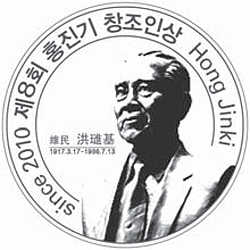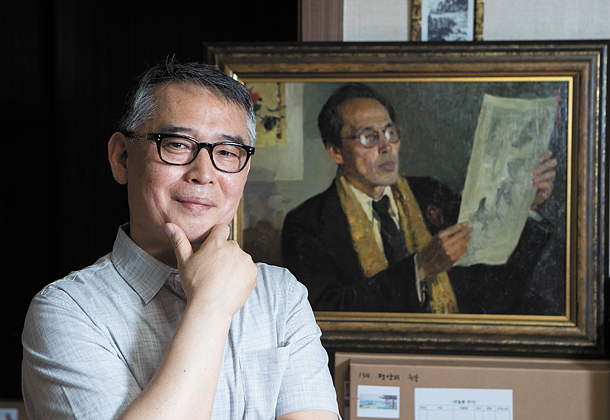Yumin Awards honor leaders in science, society, art

Kim Jin-soo, recipient in science [SHIN IN-SEOP]
The Yumin Awards were established by the nonprofit Yumin Cultural Foundation in 2010 in memory of Hong Jin-ki (1917-86), co-founder and former chairman of the JoongAng Ilbo, who was active in government, business and media during the founding of the country and throughout its industrialization.

“As opposed to existing prizes that award achievements of generations past,” said former Prime Minister Lee, “this prize focuses on the younger generation’s future possibilities in the transformation of human civilization.”
Scientist revolutionizes genome research with ‘genetic scissors’
So-called “genetic scissors” allow one to edit the human genome to treat diseases and may soon receive attention from the Nobel Prize committee.
The internationally known scientific journal, Science, called it the “2015 Breakthrough of the Year,” and last year the MIT Technology Review named it one of 10 technologies that will change the world. Kim Jin-soo, 52, director of the Center for Genome Engineering at the Institute for Basic Science, chemistry professor at Seoul National University and winner of this year’s Yumin Award in science, is a world leader in the field.
He worked on his post-doctorate at the Howard Hughes Medical Institute at Massachusetts Institute of Technology (MIT) in 1990 under the tutelage of Carl Pabo, an eminent authority in biophysics, and was involved in developing genetic scissors.
He was the first in the world to edit human genes using the Crispr-Cas9 protein, or third-generation gene scissors, in 2012.
Kim is responsible for the term “programmable nuclease,” and has written over 70 pages of research on genome editing with 20 patents in the United States and across the globe.
Genetic scissors are not actual scissors, but artificial enzymes inserted into the genome with the objective of either altering or eliminating particular regions that may prevent diseases such as human immunodeficiency virus (HIV).
This is in contrast to gene therapy, which uses viruses for delivery and does not eliminate or amend DNA.
Several years were required for the fashioning of genetic scissors in the past, but now one day is all that is necessary.
“After the third generation, Crispr, appeared, anyone can easily edit with this technology,” said Kim. “The scientific community is saying, ‘The Crispr revolution has arrived.’”
He is also the majority shareholder of ToolGen, a biotech company specializing in genome editing technology. The objective of ToolGen is the development of medical treatments through genome editing and regulation, and it is in the research stages of animal testing.
Immediately after returning from the United States in 1997, he had a brief stint at the Samsung Biomedical Research Institute (now the Research Center for Future Medicine), and it was in 1999 that he co-founded the company for genetic scissors technology, acting as CEO of ToolGen until 2005.
ToolGen was listed as a small and medium-sized enterprise at the Korea New Exchange (KONEX) in 2014, and now their market value stands at 250 billion won ($223.75 million).
Kim was appointed by the chemistry department at SNU in 2005, and since 2014 has acted as director of the IBS Center for Genome Engineering.

Choi In-cheol, recipient in society [KIM SANG-SEON]
Oprah Winfrey came from humble beginnings to become one of the most admired women in America, so what could be the secret behind her success?
Choi In-cheol, professor of psychology at Seoul National University, says Oprah’s gratitude journal was pivotal.
Choi, who works with the “Korean Happiness Class Project” at elementary, middle and high schools countrywide, says a student’s success does not depend merely on grades and numbers.
Happiness stems from finding meaning, setting goals and forming relationships in everyday life. But because teenagers are pushed to focus on university admissions and extracurricular education, they lack the opportunity for reflection.
“What is actually needed isn’t prerequisite education, but happiness, but because our students aren’t receiving this and [Korea’s] happiness index is dropping to the lowest in the world,” said Choi. “Like Oprah, I think emphasizing positive thinking is important.”
Choi initially majored in nuclear engineering at Seoul National University for two years and then transferred to the psychology department in 1988. He has since acted as a psychologist and happiness education evangelist.
His first success was in 2010 when he established the Center for Happiness Studies with SNU’s Center for Social Sciences.
The institute, sponsored by an anonymous donor, published the “Happiness Textbook” in 2011, which is filled with examples and anecdotes of people such as Oprah. The institute has provided 310,000 copies to 2,200 elementary, middle and high schools since 2012.
After publishing the book, the institute also set up a teacher training program and 7,300 teachers have attended and gone on to hold happiness classes for 960,000 students.
“The success is due to the enthusiastic participation and passion of educators who taught and learned from each other,” said Choi.
The instructors recently established a civic organization, Haengbokgagyo, to pass on their knowledge beyond the educational sphere.
The happiness class is one hour a week for a semester. Five questions form the basis of the course: have you received praise today, did you have a family member or a friend to lean on, did you learn something new, did you do something you’re the best at and were you able to freely use your time?
“Children should not be discouraged,” Choi said. “They should play a role in deciding what they want to do, and they have to know the goal behind why they have to do. Happiness comes from that.”

Moon Young-dai, recipient for culture [KWON HYUK-JAE]
It’s not easy to navigate Moon Young-dai’s studio, which overlooks Mount Bukhan in Dobong District, northern Seoul, as the space is crammed with paintings.
“I spend my days collecting the works of Byun Wol-ryung,” says Moon, an art critic and winner of this year’s Yumin Awards in culture for bringing attention to Byun’s work.
Byun Wol-ryong (1916-1990) was a Koryo-in, or ethnic Korean from one of the post-Soviet states, whose name became known to Koreans last March through the country’s first retrospective exhibition for the 100th anniversary of his birth at the National Museum of Modern and Contemporary Art (MMCA) in Deoksugung.
“It was, in truth, a pleasure to have learned of such a splendid Korean painter in the blind spot of 20th century Korean modern art history,” says Yoo Hong-jun, an art historian at Myongji University, “and I was ashamed I didn’t know his existence.”
“Unbidden tears came to my eyes,” said the poet Ko Un after visiting the museum at Yoo’s urging.
Having dedicated his life to researching Byun’s life and work after discovering him during his days as an overseas student in Russia, Moon says, “[Byun] is a creative person who connects the South and North in Korean art history.”
He adds, “I was spending my days at St. Petersburg’s State Russian Museum in 1994 when a painting caught my eye as I was passing by a corridor. I thought ‘surely Korean blood flows through that painting,’ and when I checked the name it was ‘Pen Varlen.” This is the Russian pronunciation of “Byun Wol-ryong.”
“When I went to the studio that his surviving family had watched over,” Moon says, “I felt a shudder. I found my fated task in front of a painting that expressed the history of the divided Korean nation. I will pursue the forgotten Koryo-in Byun Wol-ryung for the rest of my life.”

In the 23 years since that moment, Moon has devoted himself to marking the course of Byun’s life. Byun was a prolific artist who depicted Korean scenes in the style of Soviet socialist realism.
From 1953 to 1954, he worked at Pyongyang University of Fine Arts as a dean and adviser, developing an educational system that would become instrumental to North Korea’s home-grown socialist realism.
“What’s more important is what happens from now on,” Moon says. “There’s much to be done, the work of identifying and organizing Byun’s work, which is scattered throughout Russia, and the work of creating a touring exhibition across the country to display those paintings that were not exhibited in the South, North or anywhere else.”
BY CHOI JOON-HO, YANG YOUNG-YU, JUNG JAE-SOOK [hwang.hosub@joongang.co.kr]










with the Korea JoongAng Daily
To write comments, please log in to one of the accounts.
Standards Board Policy (0/250자)